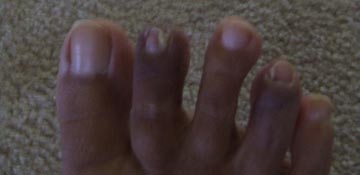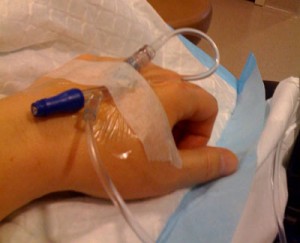I started to get some neuropathy just a few months into my first treatment, which was Thalomid. I knew it was a possibility, but I’m hopelessly optimistic, and assumed it wouldn’t happen to me. I quit taking thalidomide within 8 months, because I didn’t want the neuropathy to progress beyond a point that I thought would severely impact my quality of life.
What I ended up with is numbness in my feet and sometimes pain. It started out as a pretty intense burning feeling just three months after I started treatment in 2003. My feet felt as though they were on fire! From there, it progressed to numbness. It sort of feels like my feet aren’t my own. Shoes are no longer comfy.
After treatment with Revlimid and then Velcade, my neuropathy progressed some more. It changed a little, too. I now have some significant pain at times. I have to work with my feet up. I can’t sit at a desk, or anywhere, really, for very long. If I’m seated with my legs down for more than a half hour, I end up with pain up to my knees. I have to get my legs elevated or even lie down to get some relief.
When I first began to feel the effects of peripheral neuropathy (PN), I even had some trouble walking. I’m used to it now, so I no longer have to keep my eyes on my feet when I walk. It took a while for me to adjust.
A few days ago I was attempting a an exercise that involved hopping. It was really weird, because I didn’t really know where my feet were. I had to ask someone else if my feet even left the ground! That evening, while I was walking the dog, I tried something I hadn’t done in ages. I tried skipping, just for the heck of it. I couldn’t do it! Is that something I forgot how to do, or is the PN messing with me?
I decided to look for some information on the web, and found some facts on Livestrong.com:
What are the symptoms of neuropathy?
Peripheral neuropathy can affect the nerves which allow you to tell the position of your hands or feet, the nerves that allow you to sense hot or cold, or the nerves that carry pain sensation. The types and severity of neuropathy symptoms vary greatly. It is difficult to determine the degree of peripheral nerve injury only by the symptoms produced. Peripheral neuropathy symptoms are almost always greatest at night.
Common signs and symptoms include:
- Numbness or tingling, especially of the hands or feet
- Pain or cramping, especially of the hands , feet or calf muscles
- Sensitivity to touch or temperature
- Loss of reflexes
- Muscle wasting in the hands and feet
- Weakness, especially in the feet or hands
- Clumsiness
- Loss of balance, particularly in the dark
- Dizziness, especially when getting up from a bed or a chair
- Sexual dysfunction
Are some survivors at greater risk for neuropathy?
Neuropathy may occur from cancer or the treatment received. The following types of cancer may bring a higher risk:
- Lung
- Breast
- Ovarian
- Myeloma
- Lymphoma and Hodgkin’s disease
- Testicular
Here’s a link to the entire article: http://www.livestrong.org/site/c.khLXK1PxHmF/b.2660677/
I even found that they have a group for discussion of neuropathy secondary to drugs:
http://www.livestrong.com/groups/group/livestrong-neuropathy-secondary-to-drugs/

 the pool and I stubbed my toe on something. Toe stubbing is a more frequent occurrence for me now that I have neuropathy. It’s hard to keep track of just exactly where my feet are. Anyway, aside from hurting like the dickens, the toe injury included some broken nails. I thought nothing of it.
the pool and I stubbed my toe on something. Toe stubbing is a more frequent occurrence for me now that I have neuropathy. It’s hard to keep track of just exactly where my feet are. Anyway, aside from hurting like the dickens, the toe injury included some broken nails. I thought nothing of it.